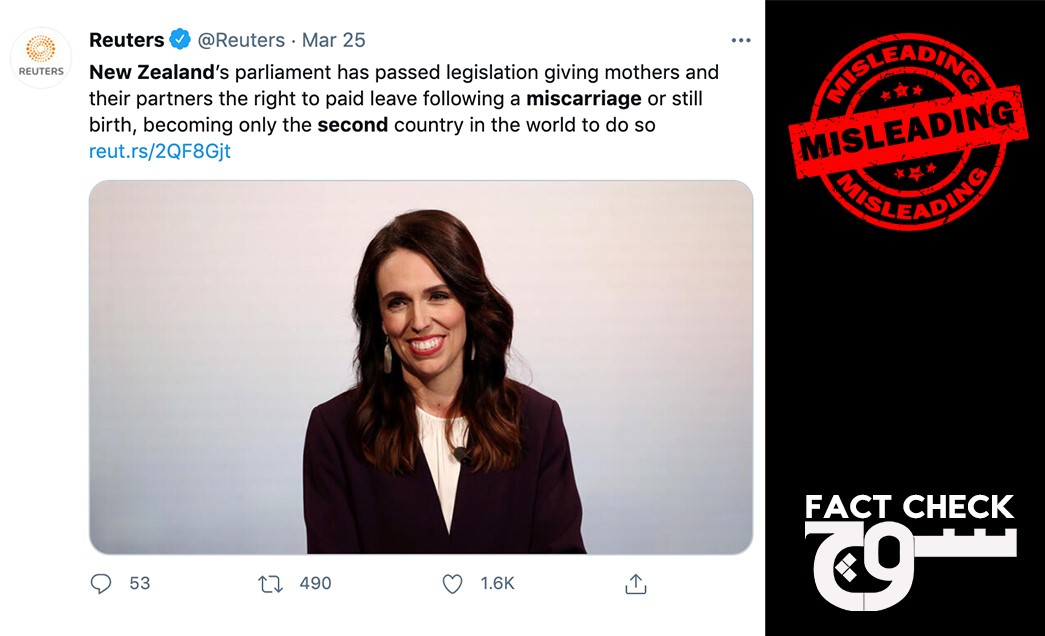
Claim: New Zealand is one of the first countries to allow for paid leave after miscarriage, second only to India.
Fact: Multiple countries have instituted paid leaves after miscarriages and stillbirths. While New Zealand is the only country to mandate leave for partners as well in case of miscarriages, other countries like Denmark and Singapore give partners leave for stillbirths.
Last month, New Zealand approved a bill to extend its 3-day bereavement leave to women who go through stillbirths and miscarriages. New Zealand’s law defines miscarriages as deliveries in the first 21 weeks of a pregnancy. The leave was also extended to partner’s of women who go through stillbirths and miscarriages, as well as former partners who are biological parents of the child. The amendment further included those who had been appointed the primary caregiver of the child, and their partners.
In many cultures, miscarriage is seen as being the fault of women, who are seen as not taking enough lifestyle precautions to ensure the health of their foetuses. Simultaneously, the severity of the experience is underplayed and women are not offered adequate empathy by healthcare workers and their families. By granting bereavement leave for both partners, New Zealand can be seen as having taken a step towards removing these attitudes and recognizing the partner’s role in recovering from the trauma of a miscarriage.
The country was hailed as being the first one to pass such a law and India was said to be the only other country to have a comparable law. Soch Fact Check found this to be misleading as India’s laws do not cover married or unmarried partners of pregnant women. Furthermore, Pakistan’s Sindh province also allows for miscarriage leave, while certain other countries have similar laws. Since the policy is not applicable for three out of four provinces, it would be misleading to say that Pakistan’s law is comparable to New Zealand’s.

Miscarriage Leaves Around the World
Under India’s Maternity Benefit Act 1961, women who have suffered from a miscarriage or still birth to take maternity leave of six weeks following the event, with paid leave equalling her average daily wage. Women who suffer from any illness due to their miscarriage or still birth are allowed an additional month of paid leave. To be eligible for these benefits, women must have worked for their employers for at least eighty days in the year leading up to the delivery. This law does not, however, give time off for partners as New Zealand does.
Mauritous also mandates three weeks of paid leave for women who have a miscarriage and 14 weeks for women who have stillbirths. Taiwan allows for four weeks’ leave for women who suffer a miscarriage after the third month of their pregnancy. Women who have a miscarriage between two and three months of getting pregnant are allowed one week of leave, while women who have a miscarriage less than a month after getting pregnant are allowed five days of leave.
Nicaragua mandates paid leave for women after abnormal deliveries, non-viable deliveries, as well an accidental interruption of pregnancy. The duration of leave is to be determined by the requirements indicated on one’s medical certificate. Panama’s labour code similarly mandates paid leave for women who undergo spontanous abortion, or have a non-viable or abnormal delivery of any kind, the duration of which is dependent on her health requirments as determined by her doctor.
Colombia and Honduras allow for paid leave of two to four weeks for women in case of spontanous abortion and non-viable premature delivery. Costa Rica, similarly, allows for a month and a half of paid leave for women who undergo unintentional abortions or non-viable premature deliveries. This period can be extended upto three months if the woman’s health requires it. Indonesia and South Africa also allow for a month and a half of fully paid leave in case of miscarriages. The Philippines similarly allows for 60 days of paid leave following a miscarriage or emergency termination of a pregnancy.
Denmark’s law allows for 14 weeks of leave for women who undergo stillbirths 21 weeks after they get pregnant, and 2 weeks of leave for their partners. The United Kingdom, also allows for miscarriage leave and stillbirth leave, though the compensation of maternity benefits varies. If a woman suffers a miscarriage before the 24th week of her pregnancy she is entitled to take paid sick leave. This leave is considered to be a pregnancy-related sick leave, which means that it does not subtract from one’s general sick leaves and is not limited. If a woman suffers a stillbirth after the 24th week of her pregnancy she is eligible for 56 weeks of maternity leave, of which she will receive maternity allowance during the first 39 weeks. Partners are also allowed 56 days of leave with statutory paternity pay.
Canada also allows for 17 weeks of maternity leave following delivery after 19 weeks of pregnancy, including miscarriages and stillbirths. The country’s various provinces have specific laws addressing the issue. Ontario, for example, gives unpaid leave if a delivery takes place 17 weeks before the expected date, while Saskatchewan gives leave for any deliveries that occur 13 weeks before the expected date.
While leaves for miscarriages are not addressed in most of Pakistan’s provincial laws, Sindh’s Maternity Benefits Act 2018, allows for 4 weeks of maternity leave for women who undergo stillbirth and one week for women who suffer from a miscarriage. Women who have worked for an employer continuously for an year preceding the expected date of their delivery are eligible for pay equalling their salary during maternity leave.
Maternity Leaves in Pakistan
Khyber Pakhtunkhwa has a similar law, albeit only for women who undergo stillbirths. The province’s Maternity Benefits Act 2013 enstates a mandatory maternity leave of six weeks following delivery and extends it to women who deliver a stillborn child after 28 weeks of pregnancy. Women who have worked for an establishment for at least four months preceding the date of their delivery are entitled to maternity benefits equalling their salary in the six weeks before delivery.
Punjab and Balochistan use the West Pakistan Maternity Benefits Ordinance 1958, which also extends its 6-week maternity leave to women who deliver a stillborn child after 28 weeks of pregnancy. Similar to KPK, women who have worked for an establishment for at least four months are entitled to maternity benefits equalling their salary from the six weeks before delivery.
Punjab and Balochistan’s laws are limited to commercial and industrial establishments, as defined in the Commercial and Industrial Employment (Standing Orders) Ordinance 1968. Commercial establishments are defined as any establishment, “which the business of advertising, commission or forwarding is conducted,” and any commercial agency. The definition also includes clerical departments of factories and industrial establishments, as well as offices that employ people for the purpose of fulfilling contractual work for other establishments. Specific businesses are also defined as commercial establishments, namely joint stock companies, insurance companies, banks, broker’s offices, stock exchanges, clubs, hotels, restaurants, cinemas, and theaters.
Industrial establishments are defined as factories, railways, as well as businesses of contractors who employ people to carry out manual and clerical work for the execution of contracts. Specific businesses are also defined as industrial establishments, namely tramways and omnibus services, docks, wharfs, jetties, in-land steam vessels, mines, quarries, oil fields, plantations, and workshops.
Summary: When New Zealand passed a law mandating paid leave after miscarriages and stillbirths, it was heralded as one of the first countries to do so, second only to India. Soch Fact Check found that other countries, like the Philippines and South Africa, have also instated miscarriage leave. Sindh has also mandated paid maternity leave for women who undergo miscarriages. However, because Sindh is the only province in Pakistan to do so, it would be misleading to say that Pakistan’s policies are comparable to New Zealand’s.
